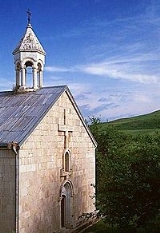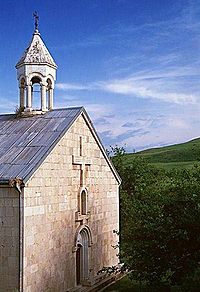
Amaras Monastery
Encyclopedia
Amaras Monastery is one of the oldest Christian sites in the world and in Nagorno-Karabakh
, and is an Armenian Apostolic
monastery located near the village of Sos in the Martuni
county of the Nagorno-Karabakh Republic
.
Amaras was the burial place of St. Gregory the Illuminator's grandson, St. Grigoris (died in 338). A tomb built for his remains still survives under the apse of the 19th-century church of St. Grigoris.
 At the beginning of the 5th century Mesrop Mashtots, the inventor of the Armenian Alphabet
At the beginning of the 5th century Mesrop Mashtots, the inventor of the Armenian Alphabet
, established in Amaras the first-ever school that used his script.
The monastery was plundered in the 13th century by the Mongols
, destroyed in 1387 during Tamerlane's invasion, and demolished again in the 16th century. It underwent radical restructuring in the second quarter of the 17th century when the surviving defensive walls were constructed.
Amaras was later abandoned, and in the first half of the 19th century the monastery served as a frontier fortress for Russian imperial troops.
The Armenian Apostolic Church
reclaimed the monastery in 1848. The monastery's church appears to have been severely damaged during the period of military occupation, to the extent that a new church had to be constructed on the site of the old one. This new church, dedicated to St. Grigoris, was built in 1858 and paid for by the Armenians of the city of Shusha
. It still survives and is a three-nave basilica constructed from bright white stone.
The monastery was abandoned during the Soviet period.
Under the altar of the St. Grigoris church is a tomb chamber reached at its western end by twin flights of steps. A blocked passage at its eastern end indicates there was originally an entrance from that direction as well. The barrel-vaulted tomb chamber is 1.9m wide, 3.75 long, and 3.5m high. The upper half of the structure originally projected 1.5 to 2m above ground level, but it is now entirely underground. Carved details date it stylistically to the 5th century.
Nagorno-Karabakh
Nagorno-Karabakh is a landlocked region in the South Caucasus, lying between Lower Karabakh and Zangezur and covering the southeastern range of the Lesser Caucasus mountains...
, and is an Armenian Apostolic
Armenian Apostolic Church
The Armenian Apostolic Church is the world's oldest National Church, is part of Oriental Orthodoxy, and is one of the most ancient Christian communities. Armenia was the first country to adopt Christianity as its official religion in 301 AD, in establishing this church...
monastery located near the village of Sos in the Martuni
Martuni
Martuni is a province of Nagorno-Karabakh Republic. It consists of the branch of Nagorno-Karabakh which juts out farthest to the east, almost reaches Stepanakert on the west, and goes a little past Karmir Shuka on the south...
county of the Nagorno-Karabakh Republic
Nagorno-Karabakh Republic
The Nagorno-Karabakh Republic , or Artsakh Republic is a de facto independent republic located in the South Caucasus region of Eurasia...
.
History
According to Armenia's 5th-century chronicler Faustus Byuzand, St. Gregory the Illuminator founded a church in what was to become Amaras Monastery at the start of the 4th century.Amaras was the burial place of St. Gregory the Illuminator's grandson, St. Grigoris (died in 338). A tomb built for his remains still survives under the apse of the 19th-century church of St. Grigoris.

Armenian alphabet
The Armenian alphabet is an alphabet that has been used to write the Armenian language since the year 405 or 406. It was devised by Saint Mesrop Mashtots, an Armenian linguist and ecclesiastical leader, and contained originally 36 letters. Two more letters, օ and ֆ, were added in the Middle Ages...
, established in Amaras the first-ever school that used his script.
The monastery was plundered in the 13th century by the Mongols
Mongols
Mongols ) are a Central-East Asian ethnic group that lives mainly in the countries of Mongolia, China, and Russia. In China, ethnic Mongols can be found mainly in the central north region of China such as Inner Mongolia...
, destroyed in 1387 during Tamerlane's invasion, and demolished again in the 16th century. It underwent radical restructuring in the second quarter of the 17th century when the surviving defensive walls were constructed.
Amaras was later abandoned, and in the first half of the 19th century the monastery served as a frontier fortress for Russian imperial troops.
The Armenian Apostolic Church
Armenian Apostolic Church
The Armenian Apostolic Church is the world's oldest National Church, is part of Oriental Orthodoxy, and is one of the most ancient Christian communities. Armenia was the first country to adopt Christianity as its official religion in 301 AD, in establishing this church...
reclaimed the monastery in 1848. The monastery's church appears to have been severely damaged during the period of military occupation, to the extent that a new church had to be constructed on the site of the old one. This new church, dedicated to St. Grigoris, was built in 1858 and paid for by the Armenians of the city of Shusha
Shusha
Shusha , also known as Shushi is a town in the disputed region of Nagorno-Karabakh in the South Caucasus. It has been under the control of the self-proclaimed Nagorno-Karabakh Republic since its capture in 1992 during the Nagorno-Karabakh War...
. It still survives and is a three-nave basilica constructed from bright white stone.
The monastery was abandoned during the Soviet period.
Tomb of St. Grigoris
St. Grigoris was originally buried at the eastern end of the now vanished St. Gregory church. In 489 Vachagan III the Pious, king of Aghvank, renovated Amaras, restoring the church and constructing a new chapel for the remains of St. Grigoris. In later centuries a church was built over this chapel-tomb.Under the altar of the St. Grigoris church is a tomb chamber reached at its western end by twin flights of steps. A blocked passage at its eastern end indicates there was originally an entrance from that direction as well. The barrel-vaulted tomb chamber is 1.9m wide, 3.75 long, and 3.5m high. The upper half of the structure originally projected 1.5 to 2m above ground level, but it is now entirely underground. Carved details date it stylistically to the 5th century.

